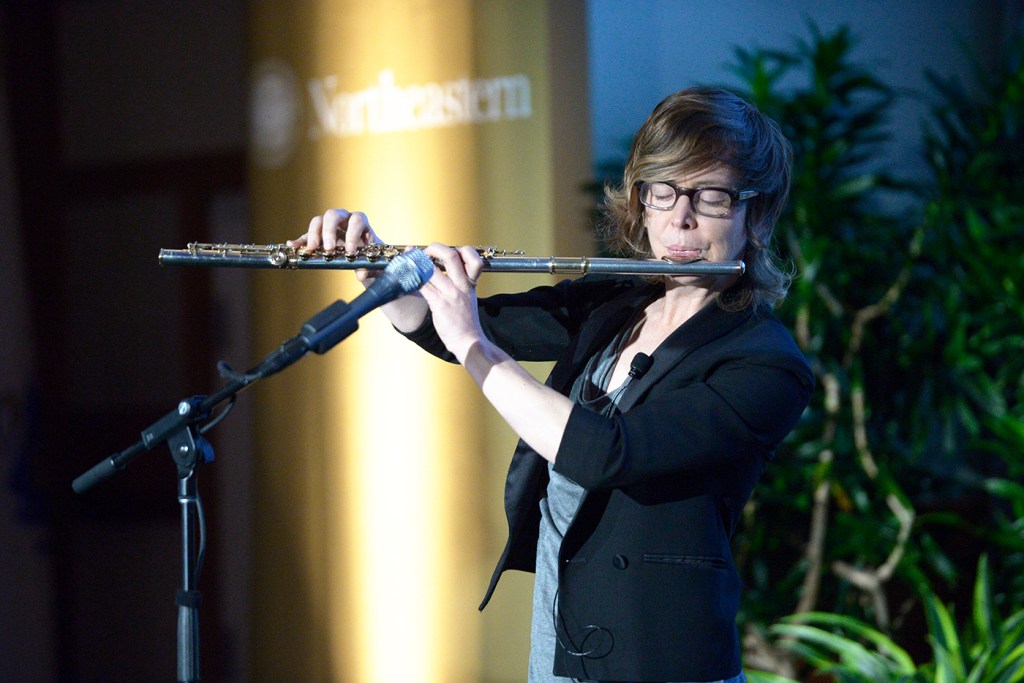The art of entrepreneurship

Claire Chase abused her “axe,” the nickname she lends to her platinum flute. She pounded on the keys with unfettered fervor, turning the wind instrument into a John Bonham tom-tom. She blew into the mouthpiece, producing high-pitched cacophony, purposely dissonant and grating. She said of her “baby:” It’s just a tube of metal with some keys. Any sounds are fair game.”
Chase, the anomalous flutist, arts entrepreneur, and 2012 MacArthur Fellow, performed in the Curry Student Center Ballroom on Tuesday evening and then gave a talk titled “Debunking, Disrupting, & Rethinking Entrepreneurship.”
Her lecture marked the latest installment of Northeastern’s Profiles in Innovation Presidential Speaker Series, which is hosted by President Joseph E. Aoun and aims to bring the world’s most creative minds to campus for conversations on innovation and entrepreneurship. Aoun himself asked Chase about a range of topics, including her interest in examining the intersection of language, music, and social interaction. “I’m very interested in exploring this idea of what we can do in the 21st century with humankind’s most ancient instrument,” she said, referring to the flute.
Here are five takeaways from the evening, one imbued with a little élan and a whole lot of art.
The art of entrepreneurship
“Entrepreneurship within the arts must begin with and end with and be rooted in the act of making art itself,” said Chase, who co-founded the International Contemporary Ensemble, a group dedicated to reshaping the way music is created and experienced. The desire to make money, she said, should not place high on the entrepreneur’s bucket list. “Entrepreneurship is not about money. It’s about agency and activism and not letting the dominant markets tell us what art we can make, how we can make it, and who are we making it for.”
No model is a good model
ICE has premiered more than 600 works since its inception in 2001 and pioneered a new artist-driven organizational model that earned the company a Trailblazer Award from the American Music Center in 2010. Despite the success, Chase and her cohort of forward-thinking artists are constantly looking for new ways to make—and share—their music with the world. “The truth about the ICE model is that it isn’t a model,” said Chase, noting that ICE musicians partner with emerging composers in intensely collaborative incubation residencies. “It’s a way of making music that’s constantly changing.” The company cancels festivals when they begin attracting too many people and move on from ingenious initiatives when other organizations start replicating them. “We frequently destruct our own models,” Chase explained. “It’s difficult to get people to let go of something when it’s successful but we do it at ICE.”
Do it yourself
Chase was asked to perform a piece of music for her junior high school graduation. She suggested “Density 21.5,” written by French-born composer Edgar Varèse in 1936 and performed by the virtuoso herself on Tuesday at Northeastern. “I became obsessed with the piece as a kid, with its power and ability to go beyond assumptions about what a flute can and should do,” said Chase, noting that Varèse’s masterpiece “blew the roof off my imagination” and compelled her to “explore new ways of understanding the world through sound.” Though Chase presented an impassioned argument for performing her new favorite piece of music for this momentous occasion, she was rebuffed by her school’s administration and forced to perform “Danny Boy,” the ballad written by English songwriter Frederic Weatherly. Being told that she could not perform such a “marvelously disruptive” piece of music taught the young flutist a valuable lesson, one she has carried with her ever since. “If I waited for someone to make space for a radical musical act, to give agency to a crazy idea, I’d be waiting my entire life.” Hence ICE.
Keeping classical music alive
In the Q-and-A, a Twitter user asked Chase to explain how classical music could be saved from extinction. “It would take great performances in thoughtful environments, whether in concert halls or wacky places we haven’t thought of yet,” Chase said. “When audiences are in the presence of something beautiful, you know it’s going to be interesting.” The primary problem with the genre, she noted, is that “the way classical music is currently presented is not interesting and is in fact alienating people.”
The campus as a canvas
Tuesday’s event showcased Northeastern’s artistic acumen. Before Chase’s lecture, a quartet of student flutists performed six pieces of music written by their peers in the College of Arts, Media and Design. After the talk, attendees flocked to the McLeod Suites for a post-event reception and pop-up art exhibit featuring student and faculty drawings, sculptures, and photographs. Henni Sundlin, AMD’14, displayed a series of photographs titled simply “Buildings of Boston.” Christopher Chu, CCIS’15, and Gregory Olsen, S’15, showcased their oil on canvas still life paintings of high heels, bowls, and water pitchers. Art + Design lecturers Jeff Hull and Sophia Ainslie—members of the university’s Public Art Initiative, which aims to provide a platform for artists to test their creative limits—displayed a total of four pieces. Ainsle’s series of acrylic drawings on paper, titled “Fragments,” derived from her interest in looking at the body and land as parallel environments. Hull’s untitled watercolor and pencil on paper called to mind the work of Jackson Pollock, the great abstract expressionist.







